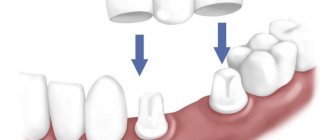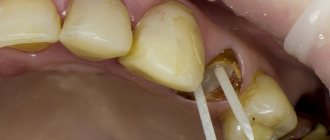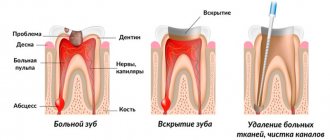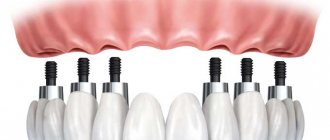Implants are a modern high-tech method of teeth restoration. Among its advantages is the absence of the need to “kill” neighboring healthy teeth, as when installing bridges, as well as full load on the jaw. Everyone experiences tooth loss. This happens for different reasons, at different ages. Restoring the dentition by installing an implant after tooth extraction is not something new for a long time. This technique has been successfully used all over the world and is completely safe.
How long can it take to get an implant if a tooth has been removed?
Until recently, it was believed that implantation immediately after extraction was risky. The higher level of modern dentistry allows immediate installation of artificial roots without any problems. Despite this, one-stage implantation is used less frequently compared to the classic two-stage method.
Possible installation times:
Simultaneously with tooth extraction - depends on the condition of the oral cavity, the doctor’s experience and the implant model. The extraction should proceed without complications, and the hole should be within acceptable dimensions. The presence of these conditions can only be known after removal.
- Advantages: the bone does not atrophy.
- Disadvantages: relatively higher risk of complications.
- Features: lack of complete sanitation of the oral cavity, the necessary studies have not been carried out.
Single-stage implantation with instant installation
After 3-5 months , when the jawbone is completely restored. The optimal period, since the bone manages to reach the required density, becomes ready for implantation of an artificial root.
- Advantages: the oral cavity is thoroughly prepared for surgery, which reduces the risk of postoperative complications.
- Disadvantages: The patient must wait for some time.
- Features: availability of all necessary test results and research.
In a longer period - if the tooth was removed a long time ago and prosthetics were not performed.
- Advantages: complete restoration of the functions of the dentofacial apparatus.
- Disadvantages: possible development of atrophy of the jaw bone (the severity of the pathology depends on the time during which the tooth was missing).
- Features: Bone grafting required.
Opinion of a maxillofacial surgeon : “It is impossible to delay installing an implant in an empty space, since without proper load the bone will quickly atrophy. It is better to carry out implantation 2-3 months after extraction. During this time, bone and soft tissues heal completely.
Nowadays, express methods are often used, when a titanium root is placed directly into the socket of an extracted tooth. This allows us to avoid bone grafting, however, to implement the procedure, all conditions must be met, which is not always possible.”
At what temperature should the monument be erected? Installation of a monument in the rain.
It is possible to install a monument on an already poured foundation at fairly low temperatures, but the main condition is that the glue must perform its functions at this temperature. If the passport for installation adhesive for stone says that it glues at temperatures from +35 to 0 C, then it is not recommended to use it at temperatures below 0 C. The higher the temperature, the better the glue will dry.
If you choose cement as a binder between the stand and the stele, then using cement mortar at subzero temperatures is not recommended.
It is not recommended to install the monument in rainy weather, as the mounting adhesive loses its adhesion to the wet surface of the stone. In the future, water can get into poorly sealed places, freeze and thaw when temperature changes, thereby destroying the fastening site.
The stele is mounted on a metal pin installed in the stand. Therefore, the fall of the monument can be excluded, even if the glue was poorly glued to the surface. But tiles are more likely to peel off if they are glued in the rain.
The best weather for installing a monument and facing tiles is warm, dry weather. The temperature should not be too low and too high, ideally the temperature should be from 15 C to 25 C. In such weather, the foundation will dry as hard as possible and this air temperature will be very comfortable for the glue.
When to insert an implant immediately after extraction
If there is insufficient bone volume, installation of an artificial root in place of a lost tooth is possible only after bone grafting
- If there is inflammation;
- fistula, granuloma, cyst;
- against the background of diseases of the mucous membrane;
- with insufficient bone volume or pathological changes;
- if the removal was performed carelessly (severely injured hole) and more.
Contraindications also include systemic diseases :
- diabetes;
- pathologies of the endocrine system;
- oncology;
- mental disorders, depression;
- allergy to anesthetics;
- weakened immunity due to viral and bacterial infections;
- tuberculosis;
- HIV, syphilis;
- hemophilia and other blood diseases;
- chronic diseases at the acute stage, etc.
Sometimes situations arise when one-stage implantation is not completed. In this case, the operation is completed after extraction. The implant installation procedure is postponed for some time to allow the wound to heal. Next, treatment is performed according to the classical protocol.
Indications and contraindications
Not all patients can restore their teeth with implants. Like any procedure, implantation has indications and contraindications. Before planning the operation, they must be studied.
Indications:
- loss of one tooth;
- absence of the last chewing teeth in the row;
- complete absence of teeth and allergies to removable dentures.
Contraindications:
- diseases of the blood and blood-forming organs, connective tissues and mucous membranes;
- disorders of the central nervous system;
- immunopathological conditions;
- tumors;
- diabetes;
- bruxism;
- tuberculosis;
- rheumatoid arthritis;
- endocarditis.
In addition, the procedure is not allowed under 18 years of age. The fact is that at this age there is a process of bone tissue formation and bone mineralization. During this period, it is impossible to accurately predict how the implant will behave when it finds itself in the developing bone tissue.
Implantation of long-extracted teeth
Long-term absence of a tooth is fraught with thinning and atrophy of the bone. Under such conditions, the implant will not be able to be firmly fixed and function normally. The layer of bone tissue covering the structure will be too thin (less than 2 mm). Subsequently, bone destruction will occur and the upper part of the implant will be exposed.
Installation of an artificial root in place of a long-lost unit is possible only after bone grafting . This is done in one of the following ways:
- Splitting of the alveolar process - the atrophied area of the bone is sawed longitudinally. An implant is implanted into the resulting hole. The empty space is filled with a fixing substance and sutures are applied. Crown installation is possible in 2-4 months.
- Bone block transplantation (autotransplantation) - bone tissue is used from other parts of the patient’s or donor’s jaw. Engraftment lasts at least 6 months.
- Guided bone regeneration (osteoplasty) - the transplanted bone is covered with a membrane to allow bone growth. The engraftment process takes 4-5 months.
- Sinus lift - indicated for implantation of lateral superior units. The lower wall of the maxillary sinus is lifted and the resulting space is filled with bone material. The implant is installed immediately or after 4-5 months.
Question 10: Is it possible for the implant to fail?
Yes, such a prospect cannot be ruled out. No patient is immune from the fact that an artificial tooth does not take root. This can happen in the following cases:
- if an infection was introduced during the operation;
- if the patient has insufficient bone tissue;
- when a person has an allergic reaction to the material from which the implant is made;
- if the root was chosen incorrectly;
- when inflammatory processes occur in the body;
- with decreased immunity;
- if the doctor’s recommendations were not followed;
- ignoring contraindications;
- when installing low-quality implants;
- if the implant or bone tissue was damaged during installation.
If the root does not take root, good dentistry undertakes to replace it with another one, or take all possible actions to guarantee the patient a 100% result.
However, according to dental statistics, with the right approach, teeth survive in 95–97%.
Implantation methods
- Classic two-stage - implantation occurs no earlier than 2-3 months after extraction. Prosthetics are performed at the second stage after osseointegration.
- One-stage installation (instant, instant) - implantation of a titanium root into a fresh socket with sutures or installation of a gum former. Prosthetics can be performed immediately after surgery or after the implant has healed.
- One-stage installation with immediate loading - implantation with a load in the form of a temporary crown on the day of surgery.
Classic way
The traditional method has been widely used in dental practice for more than 30 years. The peculiarity is the duration of treatment, which can take up to 1 year .
Classic implantation is carried out when the wound has completely healed after tooth extraction and bone has been restored. Often there is a need to build up the latter, which delays the installation for another 4-5 months. After the socket has healed, the gum is pierced or cut to place the implant. The final stage of prosthetics occurs 4-6 months after installation.
Immediate installation of implants
Implantation is possible if there is a neat hole after extraction. The success of the operation can only be predicted after the tooth is extracted. The installed implant is covered with mucous membrane and sutures are applied. A healing abutment may be placed to maintain the “pink aesthetic.” The healing stage may be accompanied by wearing a temporary removable nylon or adhesive bridge. The method is relevant in the absence of contraindications.
Stages of monument installation (foundation, monument, fence)
Installation of the monument consists of two stages:
- Pouring the foundation;
- Tiling the base, installing a stele and flower bed. Installation of a fence.
Before pouring the foundation, you need to dig a trench for it. You should pay attention to the soil characteristics in this region. If the ground is sandy, you may have to additionally strengthen the edges of the trench for the foundation. In chernozem soil, strengthening is usually not required.
The basic rule: the soil on the grave must be well compacted. Otherwise, the foundation may skew. This is why they wait at least half a year after the funeral.
After pouring, the foundation needs about 2 weeks until it dries completely, only after which can the stele be installed on the grave. It is forbidden to pour the foundation at subzero temperatures. Because it will freeze faster than it will dry. Later, after thawing, this will lead to distortion of the monument.
Among other things, the correct technical pouring of the foundation also remains important. A team with experience in installing monuments is unlikely to do anything wrong. Our advice is to contact trusted specialists.
When the foundation for the monument is poured and completely dry, you can install a stand, stele, flower bed and tile the grave site. Granite components are attached to the concrete base using a special stone adhesive. Compliance with the operating conditions of the adhesive is a prerequisite. The temperature at which the glue must be used is indicated on the packaging or in the instructions for the glue.
Let's summarize: What conditions are necessary for a monument to stand for many years?
- Wait the necessary time until the soil on the grave completely subsides so that the monument along with the foundation does not warp (at least half a year and one whole winter).
- Pour the foundation and install the monument in the warm season.
- Do not install the monument in rainy or foggy weather.
- Use only high-quality mixtures for the foundation and fastening of granite complex elements.
- Allow the foundation to dry thoroughly before installing the monument (at least 2 weeks).
What to do with the cross after installing the monument?
The cross that stood on the grave before the installation of the monument must be handed over to the caretaker of the cemetery. If there is no such employee, then the cross must be taken to the waste disposal container. There is no need to leave an old wooden cross at the base of the grave or between the rows, as this will make it difficult for people to pass through and will cause discontent among cemetery visitors.
The cemetery administration knows where to remove the old cross and will do it themselves if you take it to the trash container. If you leave it in the area of the grave, they will not be able to notice it right away and there is a chance that it will lie there for a long time.
If a special team installs a monument, it will remove the cross from the cemetery itself.
You might be interested in: How to install a monument yourself?
Price
The cost of row reconstruction by implantation depends on factors:
- brand of implantation system;
- artificial crown material;
- treatment protocol.
Scientific Dentistry Dantistoff has special offers for turnkey installation of implants, payment in installments is possible.
Link to the fortieth memorial day
For 40 days, at home or in a restaurant, they organize a wake for the deceased, go to church, pray and light candles for the repose. You can also go to the cemetery to remove old, withered flowers and tidy up the grave. The clergy recommend doing this directly on the fortieth day or the day following it.
A memorial service can be ordered at the church for forty days. The place of the soul of the deceased has already been determined; it has gone to Heaven or Hell, but relatives and friends are obliged to remember it. Many are in a hurry to order a tombstone by the fortieth day in order to install it on the grave. This is not prohibited by religion, you can start the installation the day after the funeral, but it’s absolutely not practical. It’s better to spend the next commemoration in prayer for the soul; all worldly matters can wait.
Price
- Primary appointment (examination, consultation) with a dentist (special offer) 100001
For free
Promotion
- Removal of permanent tooth 160002
3 900 ₽
- SGS implant + turnkey crown
24 900 ₽
Promotion
- Osstem implant + turnkey zirconium crown
29 900 ₽
Promotion
- Astra Tech implant + turnkey zirconium crown
59 900 ₽
Promotion
- Nobel implant + turnkey zirconium crown
59 900 ₽
Promotion
- Straumann implant + turnkey zirconium crown
59 900 ₽
Promotion
to insert the tooth in place of the removed one as soon as possible. The absence leads to functional disorders of the maxillofacial apparatus and deformation of the dentition. Timely elimination of single defects through implantation helps preserve the volume of the jaw bone and a healthy bite. The method involves implanting an implant into the jawbone, onto which an artificial crown is fixed. Replaces the sub- and supragingival part of a missing tooth - restores aesthetics and performs a chewing function.
How to obtain permission to install a monument on a grave
You can obtain permission to install a monument from the cemetery administration. If the cemetery is small and there is no separate administration, then you should go to the administration of the locality, for example, the village council. After presenting the death certificate, you receive permission to install the monument. With the received certificate for the installation of a tombstone, you can begin to remove the old monument or cross and begin installing a new monument.
To obtain a certificate of permission, you must present the following documents to the cemetery administration:
- Passport of the person responsible for the burial;
- Certificate for the grave;
- Contract for the production of a monument with a paid receipt;
- Application for installation of a tombstone by cemetery employees or an authorized installation team.
Very often, the installation of monuments in a cemetery is carried out by a team of installers attached to the cemetery. Some cemeteries are closed to third-party organizations involved in the installation of monuments. Even to independently install a tombstone on a relative’s grave, you must obtain permission from the cemetery administration, and not in all cases the administration gives a positive decision.
Share the article on social networks
General comparison
Of course, spring is considered the season for installing fences. But, as it turned out, autumn also has its advantages when performing such work. As mentioned, construction materials prices drop at this time of year, so you may want to cut back on your construction budget. It is also worth choosing the installation method wisely.
With the right selection of materials and favorable weather, choosing the autumn season can be very successful and profitable from a financial point of view. In general, we can say that each described time is attractive in its own way for those who want to improve their local area.











